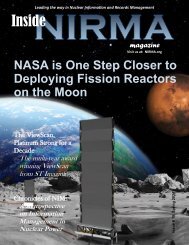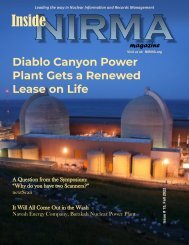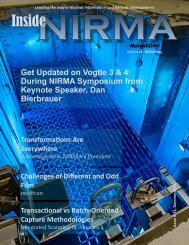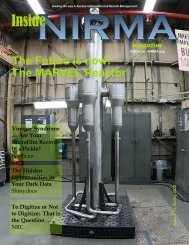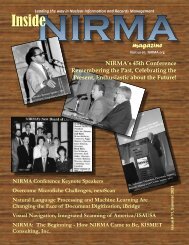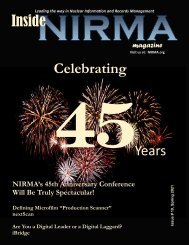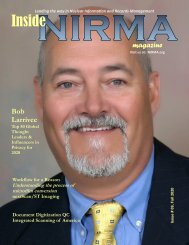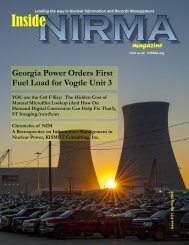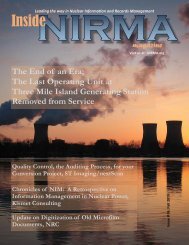Summer Inside NIRMA Issue
Create successful ePaper yourself
Turn your PDF publications into a flip-book with our unique Google optimized e-Paper software.
By Tim Riti and Jim Slider<br />
It is hard to believe that 25 years<br />
ago, the Reactor Oversight Process<br />
(ROP) was born. After evaluating<br />
various top-down approaches to<br />
assess industry regulatory<br />
performance, the Nuclear Regulatory<br />
Commission (NRC) worked with the<br />
Nuclear Energy Institute (NEI) to<br />
develop a risk-informed approach to<br />
reactor oversight. This required<br />
many public meetings over the<br />
course of two years, and pilot testing<br />
at eight nuclear power plants. These<br />
plants (Salem/Hope Creek,<br />
Fitzpatrick, Harris, Sequoyah, Prairie<br />
Island, Quad Cities, Fort Calhoun,<br />
and Cooper) set the stage for this<br />
revolutionary oversight approach<br />
that was ultimately accepted and<br />
approved by the five NRC<br />
commissioners.<br />
The ROP provides a clear<br />
framework for combining inspection<br />
results with objective performance<br />
indicators reported to the NRC to<br />
measure the regulatory performance<br />
at each U.S. nuclear power plant.<br />
The beauty in this approach was its<br />
openness, predictability, and<br />
objectivity. Over these 25 years, the<br />
ROP has slowly evolved as industry<br />
performance improved and riskinformed<br />
processes were<br />
implemented. While industry<br />
operating experience and NRC selfassessments<br />
informed some<br />
improvements to inspections and<br />
performance indicators, there is<br />
more to do to ensure the ROP keeps<br />
serving its intended purpose. The<br />
industry and NRC continue to<br />
discuss improvements to the ROP<br />
and evaluate its effectiveness. This<br />
long-running dialogue between<br />
NRC, NEI and the public has served<br />
all stakeholders well.<br />
Today, the U.S. nuclear fleet<br />
operates more safely and efficiently<br />
than ever before. While the ROP has<br />
come a long way since its inception,<br />
it cannot be allowed to stagnate. The<br />
ROP must continue to evolve and<br />
modernize as the industry’s safety<br />
and reliability continue to improve.<br />
This is the key to ensuring NRC and<br />
industry resources are applied where<br />
they contribute the most to safety<br />
and public confidence in nuclear<br />
energy. Effective and efficient<br />
regulation is vital for nuclear power<br />
to play a critical role in meeting the<br />
Nation’s decarbonization and energy<br />
security goals.<br />
Article reprinted with permission of<br />
NEI. Read full article here.<br />
Back to Content | <strong>Inside</strong> <strong>NIRMA</strong> <strong>NIRMA</strong>.org <strong>Summer</strong> 2024 31



